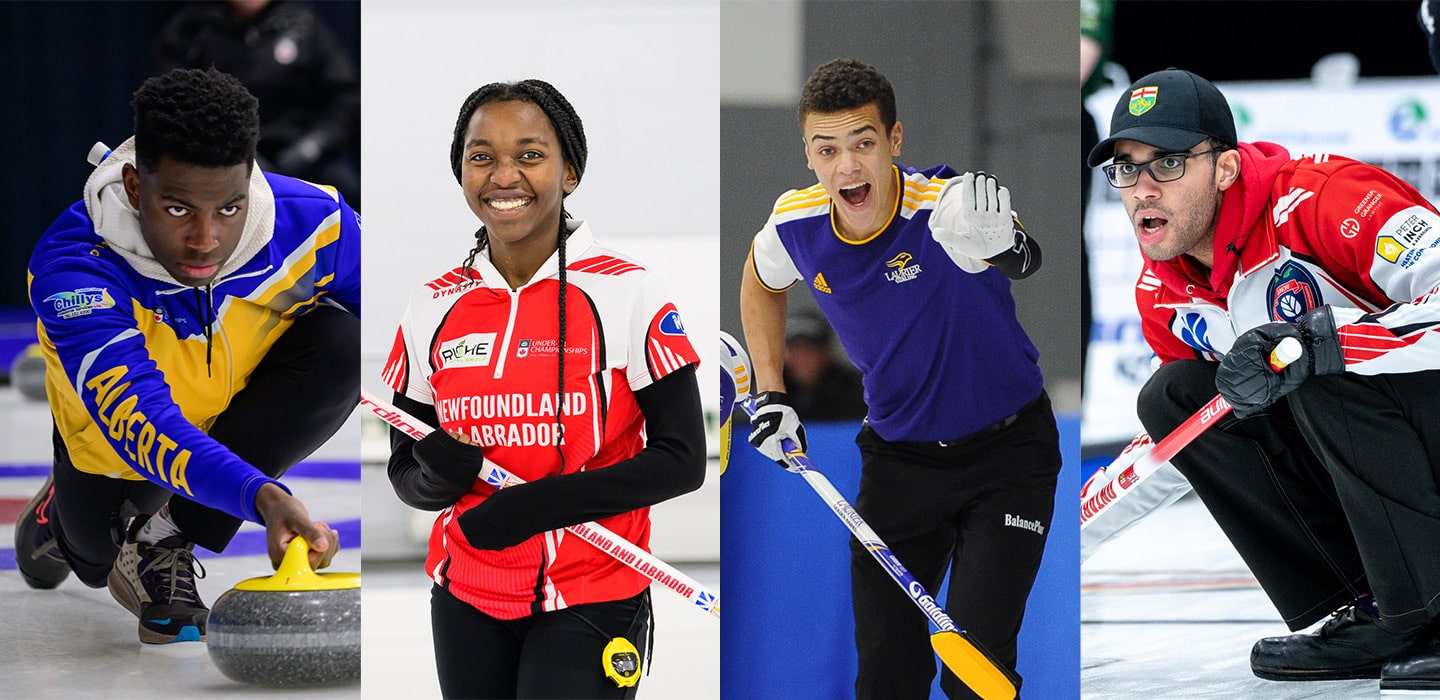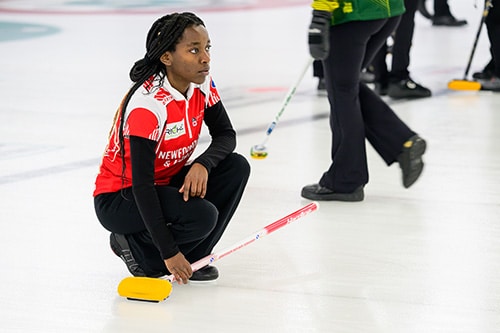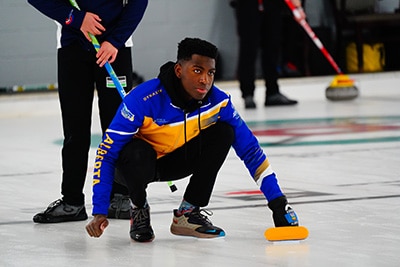Black History Month

Young Black curlers are paving the way towards inclusion for BIPOC Canadians
Black History Month honours the legacy of Black people in Canada and their contributions to our communities, both past and present. In curling, we look ahead with numerous Black athletes setting the tone for the future of the sport, while honouring the existing histories of Black and racialized people in curling.
With new programs introducing Black Canadians to curling, there are opportunities for more representation of the full range of participants within the sport. It adds to the rich narrative that exists within curling, which reflects how the demographics within Canada are becoming more diverse and multicultural.
Sitaye Penney
Sitaye Penney of Portugal Cove – St. Phillips, N.L., has curled for as long as she can remember. Since age five, she’s been at the RE/MAX Centre, St. John’s Curling Club, slinging rocks up and down sheets of ice. She started curling in Little Rocks on Saturday mornings, and as she got older, she participated in the after-school programs. As she developed her skills, she soon worked as an instructor in the curling programs she participated in as a young girl.
In 2017, she decided to go all in on the sport. Inspired by Brad Gushue’s Brier-winning performance on home soil in St. John’s, she got hooked on the game’s energy. She wanted to take her game to the next level and compete with the best. If Gushue could do it, so could she.
“It was like, OK, I like this sport a lot and want to stick with it. Hearing the reaction in the building when he won was electric, and something made me go, I want to do this. The whole arena was packed and there to see him play. Seeing everyone jump out of their seats screaming and yelling and cheering them on was just great,” Penney said.
And she’s found that success. Penney has now represented her province four times over the past few years. 2024 marks her third Canadian U-18 championship, and she competed at the 2023 Canada Winter Games.

Penney’s community represents as predominantly white, as such, she did not think much about being the only Black Person in her club.
“It was just a realization that I was the only one, and I wanted to see a change. I want to make a difference,” she said.
Penney took action. She received one of the inaugural Fran Todd All Heart Junior Curling Awards and targeted newcomers to Canada and other racialized persons, creating a different type of safe space for them to try the game. Due to her passion and drive, the program was a resounding success with over 20 participants, bringing families onto the ice in an intergenerational format. Thanks to Penney’s program, over half of those participants have continued curling.
“I think these programs are really important. A lot of new Canadians might not know what curling is. They may see it, but they don’t fully understand it. Getting them out there and trying it judgement-free is a really good thing,” she said.
Penney’s commitment is also impacting her community, as one of her clubmates Simon Perry, was awarded a Fran Todd All Heart Junior Curling Award bursary in 2023, implementing yet another program designed to serve historically underrepresented and marginalized people. The result has been a two-fold increase due to a partnership with the Association of New Canadians, inviting a wider range of participants from backgrounds such as Black, Indigenous, Middle Eastern and Asian.
Penney understands that even as a young curler, she serves as a role model for others in the Black community. While this is a vital part of what she brings to the sport, she also believes in a broader impact paving the way for all girls to participate in the curling.
“I want to show them [all girls] that you can do anything, that’s what I’m all about. It doesn’t matter about race or gender or anything else,” she said.
One day, she wants to represent her province at the Scotties Tournament of Hearts. But her desires don’t stop there.
“I want to win,” she said, as her face lit up with pride.
Jaxon Hiebert
As a youngster, Jaxon Hiebert possessed an insatiable energy that could not be fully realized being at home. His parents encouraged him to go across the street to the curling club, that could be seen from his front window.
Hiebert became a fixture at the Sexsmith Curling Club in northern Alberta, and allowed him to throw stones whenever he wished, even having members help teach him additional skills along the way. Hiebert loved to throw stones, listening to the echoes of them sliding through the empty ice shed. Hiebert’s commitment was evident, and many people including the club’s ice tech aided in his development, gave Hiebert new skills to work on each week. His practise, combined with participating in the Little Rocks program, grew his love for the game, especially the complex strategy that is required to compete at higher levels.

At the age of 10, Hiebert was invited to play on a team competing at the U-20 provincial championships. His teammates, being twice his age, recognized the skill and expertise in his game, and believed he would be a valuable addition. That experience opened his eyes to what the future could be for him.
“I want to get better at this and do this. Ever since then, I’ve been on a team with my now coach [Les Sonnenberg] and have developed as a player and athlete through that,” Hiebert said.
Hiebert continued his competitive development competing at three national U-18 championships, which included this year’s in tournament in Ottawa as well as the 2023 Canada Winter Games. Hiebert progression and commitment to the sport even led his family to prioritize his development moving to Sherwood Park to reduce the up to 10 hours or more they spent on the road to competitions. Curling out of the Sherwood Park Curling Club also has benefitted him with mentorship from Scotties champion Heather Nedohin. For Hiebert and his family, the result has been better access to training and competitions, and accelerated skill development.
Hiebert was a standout performer at the national championships and was selected to compete in a mixed doubles best-of-seven series with a chance to compete at the 2024 Youth Olympic Games. A historic win would have made Hiebert the first Black athlete to represent Canada in curling at an international competition. However,
Hiebert and his partner Lauren Evason of Manitoba came up one game short of the ultimate goal. Even though the loss was a difficult experience, the training over the summer and competitions was a valuable platform for things to come.
“It was one of the coolest experiences of my life. I’d never played with my back against the wall like that before. It taught me I can be gritty and determined, and we almost pulled through. I think it’s been fueling me this year. I want to get back, and I want to wear that Maple Leaf. That’s what I remind myself of when I’m training,” Hiebert said.
Hiebert would love to see the game be more representative the of the Canada that he has grown up with. While curling came naturally into his life, Hiebert recognizes that it isn’t always the case, especially for racialized persons. He understands that he can play a role in helping others feel as comfortable in the sport as he does, exemplified by his connection to UnitedWeCurl, a national not-for-profit dedicated to creating safter spaces for racialized and marginalized people to belong in curling. Ultimately, Hiebert wants to introduce others like him to the sport that has given him so much.
“I’ve been taking my career year-by-year. Now, as I look back, I think I’m more aware of things, how fortunate I’ve been throughout the years, and the cool people I’ve been able to meet. Curling has given me such a gateway to so many different opportunities. I’ve got to meet some amazing people and I’m forever grateful for that,” he said.
Jayden King & Kibo Mulima
Last month, Jayden King and Kibo Mulima made history at the Ontario Tankard, marking the first time two Black skips have competed against each other in the provincial championship. The narrative points to exceptional competitors going head-to-head, but also teases a shift, potentially toward a future for curling more representative of Canada’s full demographics.
King and Mulima joined Fresh Air with Ismaila Alfa on CBC Radio (listen to the full interview here) to discuss the milestone and growing diversity in the sport.
“We found out that when Jayden and I played each other, it was what we think is the first time two Black skips have faced each other at the Ontario Tankard, which is a bit surprising that it has taken until now. It’s a cool moment we got to be a part of, but it’s a little bit of an indicator of how things are moving along for this kind of new generation that Jayden and I are a part of, but I would say there is still a lot of work to be done,” Mulima said.
The plot was not lost on King and Mulima, however, they also recognize that there is still work to be done, especially regarding awareness of the sport for racialized persons and that the belong.
“Curling is taking strides to increase the diversity, but I think we can definitely just focus on awareness. Not many people know about curling and not many people know where the curling clubs are and how to get started. It’s about raising awareness to the sport and that the sport is open for anybody of any ability of any age to try and have fun and how social it is and how it’s a great place to meet new friends and feel like a part of a community,” King said.
They identified that funding programs that create different types of spaces for non-traditional curlers are vital and with an already have a proven track record, there is appetite for more to come.
Penney saw firsthand how specialized programs available to BIPOC Canadians make a difference, too. To do that, she believes the path forward is to allow for time to train new curlers and provide teaching, assistance, equipment, and other expenses related to the sport.
“I think it’s really cool how participation and awareness and it’s expanding,” Penney said. “Curling Canada and curling in general are showing they want to be more inclusive and that shows other people how to be as well.”
These amazing individuals are part of the future of curling. They show that representation matters. While there’s work to do, these stories indicate a sport that is taking positive strides forward to invite, welcome, and make everyone feel they belong.




